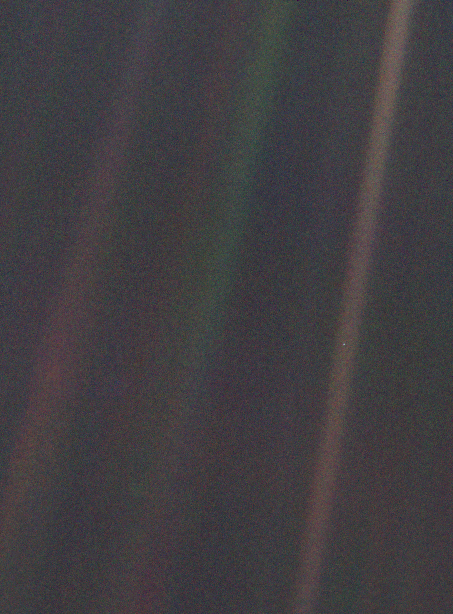Pale Blue Dot
An image from the edge of the solar system
Pale Blue Dot is an image taken by the spacecraft Voyager 1 on February 14, 1990, as it was leaving our planetary neighborhood to reach the outer skirts of the Solar System.
It was taken at the suggestion of Carl Sagan, a U.S. astronomer and science communicator.
The engineers at NASA commanded the spacecraft to turn around for a last look at its home planet and capture this awe-inspiring image. According to the Planetary Society, the image was taken as part of Voyager 1’s last photographic assignment, which captured family portraits of the Sun and planets.

Pale Blue Dot captured in 1990
The approximate distance of Voyager 1 from the Earth at the time this image was taken was 6.4 billion kilometers (or 4 billion miles) away, while it was at 32 degrees above the ecliptic plane (the imaginary plane containing the Earth’s orbit around the sun).
A humbling experience
Engulfed in the vast and enveloping cosmic dark, at the center of scattered light rays (the result of taking a picture so close to the sun), the Earth appears merely as a crescent of 0.12 pixel in size, a tiny dot of pale light.
It sends chills down my spine to think about how everyone that we have ever known, or heard of, lived out their entire lives on something so small and almost unidentifiable from the expanse of space.
The first time I came across this image, I wasn’t sure how to feel. Awe, pointlessness, hope, curiosity - all of them came crashing down, shattering my walls of self-importance and conceit. After all these years, I still marvel at it and wonder if I will ever be able to truly comprehend the significance of this image.
There is one thing that I know for certain, though. That is, it is a truly humbling experience, and I am increadibly privileged to have witnessed it.
A quote from Carl Sagan
The image later became the inspiration for Carl Sagan to write one of his books, Pale Blue Dot: A Vision of the Human Future in Space.
There is an excerpt from his book that is dedicated to explore the many implications of the image. It is exceptionally well-written, offering us a perspective that is truly cosmic.
I would just like to quote a few sentences that I find encapsulate so well the essence of the image.
The Earth is a very small stage in a vast cosmic arena. Think of the rivers of blood spilled by all those generals and emperors so that, in glory and triumph, they could become the momentary masters of a fraction of a dot. Think of the endless cruelties visited by the inhabitants of one corner of this pixel on the scarcely distinguishable inhabitants of some other corner, how frequent their misunderstandings, how eager they are to kill one another, how fervent their hatreds.
Our posturings, our imagined self-importance, the delusion that we have some privileged position in the Universe, are challenged by this point of pale light. Our planet is a lonely speck in the great enveloping cosmic dark. In our obscurity, in all this vastness, there is no hint that help will come from elsewhere to save us from ourselves.
It has been said that astronomy is a humbling and character-building experience. There is perhaps no better demonstration of the folly of human conceits than this distant image of our tiny world. To me, it underscores our responsibility to deal more kindly with one another, and to preserve and cherish the pale blue dot, the only home we’ve ever known.
December 2021 - Melbourne, Victoria.
The full excerpt above is available here, courtesy of the Planetary Society. Or, if you prefer, there is a narrated version by Carl Sagan himself on Youtube, available below.
Thanks for reading! Check out my projects and other posts as well if you would like.